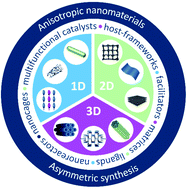Anisotropic nanomaterials for asymmetric synthesis
Abstract
The production of enantiopure chemicals is an essential part of modern chemical industry. Hence, the emergence of asymmetric catalysis led to dramatic changes in the procedures of chemical synthesis, and now it provides the most advantageous and economically executable solution for large-scale production of chiral chemicals. In recent years, nanostructures have emerged as potential materials for asymmetric synthesis. Indeed, on the one hand, nanomaterials offer great opportunities as catalysts in asymmetric catalysis, due to their tunable absorption, chirality, and unique energy transfer properties; on the other hand, the advantages of the larger surface area, increased number of unsaturated coordination centres, and more accessible active sites open prospects for catalyst encapsulation, partial or complete, in a nanoscale cavity, pore, pocket, or channel leading to alteration of the chemical reactivity through spatial confinement. This review focuses on anisotropic nanomaterials and considers the state-of-the-art progress in asymmetric synthesis catalysed by 1D, 2D and 3D nanostructures. The discussion comprises three main sections according to the nanostructure dimensionality. We analyze recent advances in materials and structure development, discuss the functional role of the nanomaterials in asymmetric synthesis, chirality, confinement effects, and reported enantioselectivity. Finally, the new opportunities and challenges of anisotropic 1D, 2D, and 3D nanomaterials in asymmetric synthesis, as well as the future prospects and current trends of the design and applications of these materials are analyzed in the Conclusions and outlook section.

- This article is part of the themed collection: Recent Review Articles


 Please wait while we load your content...
Please wait while we load your content...